Mad Hedge Biotech and Healthcare Letter
December 19, 2024
Fiat Lux
Featured Trade:
(SURVIVAL OF THE SOLVENT)
(KOD), (GOSS), (BLUE), (SIOX), (CDAK), (GLPG)

Mad Hedge Biotech and Healthcare Letter
December 19, 2024
Fiat Lux
Featured Trade:
(SURVIVAL OF THE SOLVENT)
(KOD), (GOSS), (BLUE), (SIOX), (CDAK), (GLPG)

The biotech industry likes to measure success in breakthroughs, but 2024 taught us to count it in survivors.
Sure, we saw remarkable wins in schizophrenia and obesity treatments - enough to keep Big Pharma writing checks that would make anyone pause.
But those layoff numbers? They keep climbing, and I've seen enough market cycles to know what that means.
Yes, the Nasdaq Biotechnology Index eked out a 5.4% gain in 2023, but don’t let that calm surface fool you.
Beneath it, some companies were taking on water faster than a paper boat in a tsunami. It’s not exactly the environment to make your local biotech cheerleader grin ear to ear.
Still, there is value in understanding what went wrong.
Take Kodiak Sciences (KOD) - and I mean that literally because the market sure did. They watched their high hopes for an age-related macular degeneration treatment encounter the brick wall of trial results that proved no better than existing standards of care.
The market’s reaction was swift and merciless, erasing more than 70% of Kodiak’s valuation. Back in my hedge fund days, we called this kind of drop a "character-building event."
Then there's Gossamer Bio (GOSS), which missed its endpoints in pulmonary arterial hypertension so badly you'd think they were aiming for a different disease altogether.
They learned the hard way that lofty ambitions can deflate at high altitudes when critical endpoints fail to materialize, leaving the company staring at a gaping hole where investor confidence used to be.
Bluebird Bio (BLUE)? They've been playing regulatory red light green light with their gene therapy platform.
Despite having the science that could make this possible, they struggled to justify the hefty R&D spending necessary to bring complex and costly treatments to a market that can turn stingy when results arrive late and uncertain.
Speaking of tough breaks, Sio Gene Therapies (SIOX) discovered the cruel reality that neurodegenerative pipelines rarely behave the way spreadsheets say they should.
And poor Codiak BioSciences (CDAK) - their exosome therapy platform imploded so spectacularly that they were forced to declare bankruptcy.
Even Galapagos NV (GLPG) found itself stuck reassessing once-promising late-stage candidates. Those strategic alliances they bragged about last year aren't looking quite so strategic anymore, either.
It would be easy to pin the blame on management missteps or scientific overreach, but the numbers are showing something else.
FDA’s Center for Drug Evaluation and Research did not exactly smile on the biotech crowd’s ambitions. In 2022, it approved 37 novel drugs. By December 2023, fewer than 30 had made the cut.
Want more sobering statistics? The probability of a drug making it from Phase I to FDA approval sits at 7.9%. In immuno-oncology alone, we've got over 1,500 active trials fighting for attention. Overcrowding would be an understatement.
Meanwhile, global biopharmaceutical R&D spending topped $200 billion in 2022 - that's a lot of investor cash burning through labs with no guarantee of return.
Remember the IPO party from a few years back? Well, 2023 saw fewer than 20 biotech IPOs brave the public markets. That's not caution - that's fear.
For those still interested in this sector - and I know you're out there - some of these disasters might offer lessons, or even opportunities.
The iShares Biotechnology ETF exists for those who prefer to spread their risk. Smart move, considering what we've seen this year.
Let's talk specific names. Bluebird Bio might still have a chance if they can get their regulatory act together and convince insurers to cover their therapies.
Sio Gene Therapies could find new partners - though I wouldn't hold my breath. Galapagos has Gilead (GILD) in their corner, which counts for something in this market.
So here's my take: hold Kodiak if you can stomach more volatility - they've already taken their biggest hits.
Same goes for Bluebird Bio, but only if you've got patience. Galapagos? Keep it, but watch those pipeline updates like a hawk.
Gossamer Bio? Time to consider an exit. Sio Gene Therapies lacks catalysts, and Codiak - well, bankruptcy speaks for itself.
The lesson from Kodiak, Gossamer, Bluebird, Sio, Codiak, and Galapagos is simple: brilliant science means nothing without solid analysis, realistic timelines, and serious cash. 2024 proved that point six times over.
Sure, everyone in biotech wants to change the world. The hard part? Staying solvent long enough to make it happen.
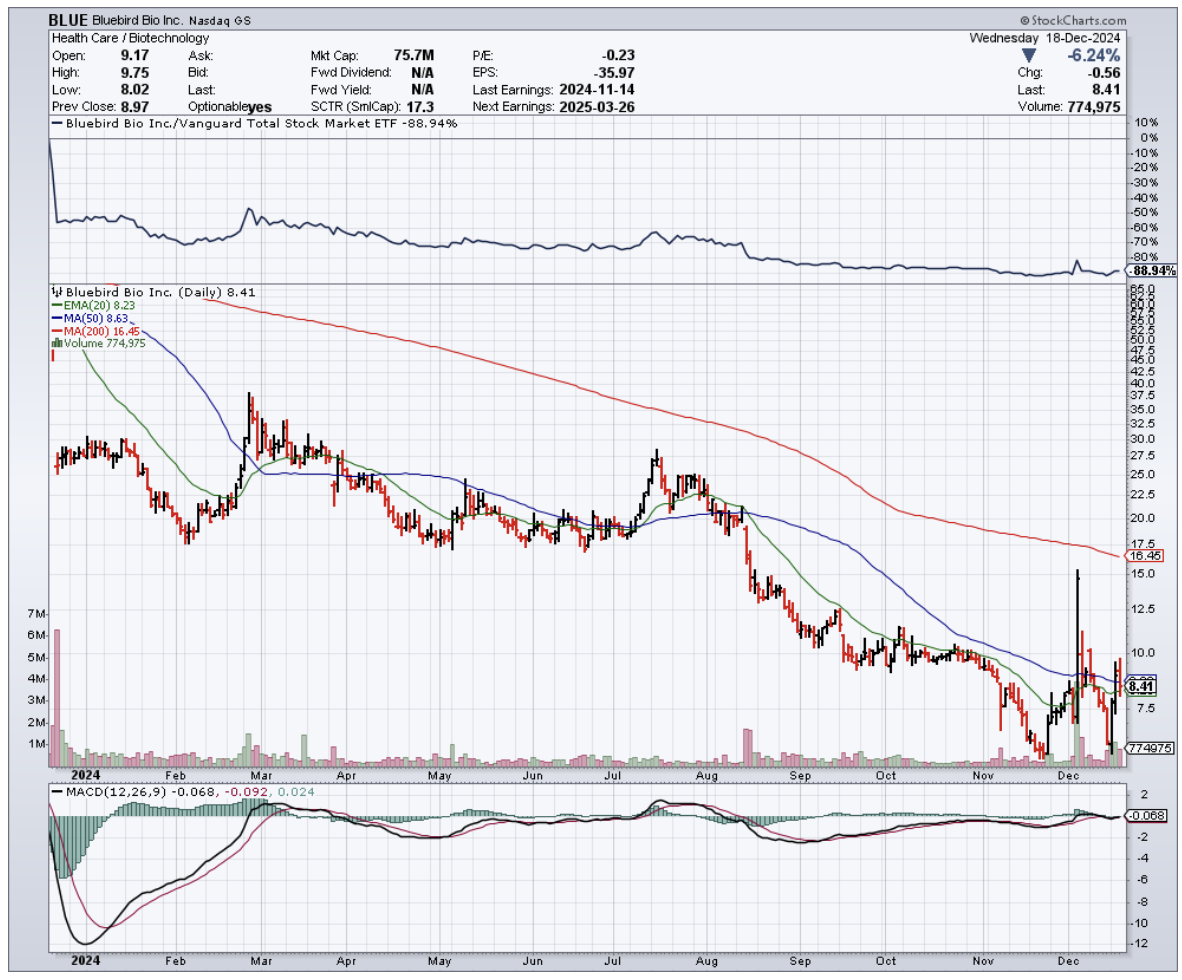
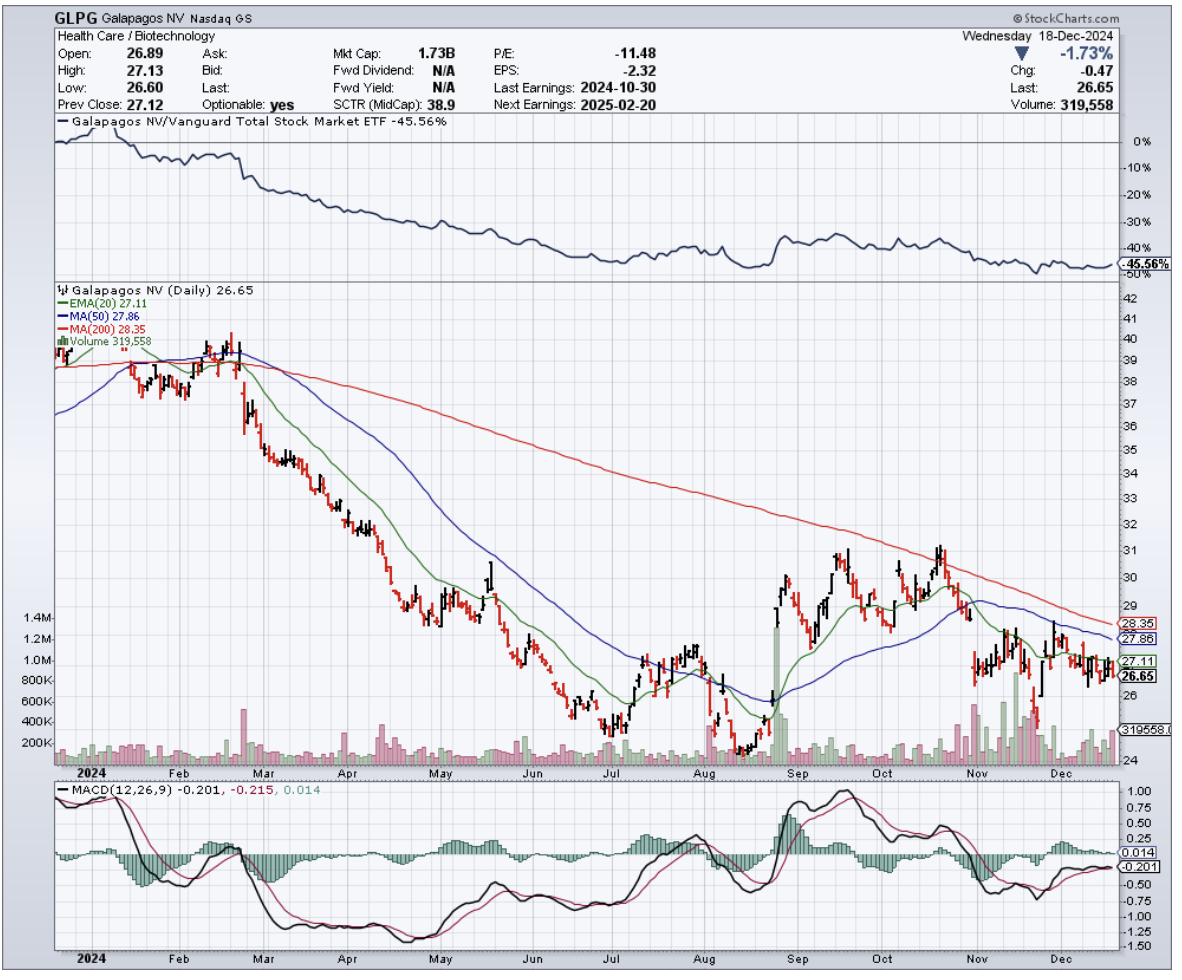
Mad Hedge Biotech and Healthcare Letter
December 14, 2023
Fiat Lux
Featured Trade:
(EDITING YOUR PORTFOLIO)
(CRSP), (VRTX), (BLUE), (BEAM), (CRBU), (EDIT), (NTLA), (PRME), (VERV), (LLY), (REGN)

In the world of biotechnology, the buzz these days is all about gene editing – a frontier that’s moving at warp speed.
While the journey from sequencing the first human genome took a staggering 13 years, companies like CRISPR Therapeutics (CRSP) have sped up the process, bringing their revolutionary "molecular scissors" concept to market in a mere decade.
It's a thrilling time for investors, with the potential for staggering returns, but the path is littered with clinical and regulatory landmines. This turns choosing the best stocks to put your money into a tricky challenge.
Recently, the FDA gave the green light to two groundbreaking gene therapies for sickle cell disease, developed by Vertex Pharmaceuticals (VRTX) in collaboration with CRISPR Therapeutics and by Bluebird Bio (BLUE).
This disease, predominantly affecting African-American communities in the U.S., has been a target for medical advancement for years.
While the approval is a landmark, it's not without its tremors. Bluebird Bio's stock took a nosedive by 33.9%, triggered by the FDA’s warning label about potential cancer risks linked to their treatment.
In contrast, the treatment by Vertex and CRISPR dodged such warnings, possibly giving it an edge in the eyes of prescribing doctors.
And then there’s the money side of things. Bluebird Bio missed out on a priority review voucher from the FDA, which they were hoping to sell to Novartis for a cool $103 million. That's a tough break.
Meanwhile, the Vertex and CRISPR therapy, now known as Casgevy, boasts the honor of being the first FDA-approved drug using the trailblazing Crispr/Cas9 technology. It's a Nobel Prize-winning innovation that's finally reaching the patients it promises to help.
The approvals of Casgevy and Bluebird Bio’s Lyfgenia, which arrived earlier than expected, mark a significant moment for patients with sickle cell disease.
Although priced in the millions, these treatments offer a potential one-time cure, replacing the traditional, complex regimens. Unfortunately, they are not without their challenges, involving intensive procedures, lengthy hospital stays, and chemotherapy.
This brings us to the investment side of things.
The gene-editing arena is brimming with potential, but it's akin to navigating a labyrinth. With no specific exchange-traded funds (ETFs) focusing solely on gene editing stocks, investors might feel like they're trying to find their way in the dark.
However, a diversified approach could be the lantern in this darkness.
Companies like Beam Therapeutics (BEAM), Caribou Biosciences (CRBU), Editas Medicine (EDIT), Intellia Therapeutics (NTLA), Prime Medicine (PRME), and Verve Therapeutics (VERV) are some of the key players in this space, each with its unique technological platform.
But it's not just the pure-play gene editors that are worth your attention. Giants like Eli Lilly (LLY), Regeneron Pharmaceuticals (REGN), and Vertex Pharmaceuticals have thrown their hats into the ring, making substantial investments in gene editing.
So, how should you play this? If it were my money, I'd spread it around.
Put a chunk in leaders like CRISPR and Intellia. Then, combine these with established players like Eli Lilly, Regeneron, and Vertex to provide a safety net, balancing out the inherent risks of this high-stakes biotech game.
On the other hand, companies like Beam and Verve, representing the next wave of this technology, should not be overlooked, though perhaps with a more conservative stake.
And here's a little hedge for you: keep an eye on smaller players like Caribou Biosciences and Editas Medicine. In this high-stakes game, they could be your ace in the hole.
The gene-editing industry is a roller coaster of innovation, risk, and potential. It's a sector where fortunes can be made and lost in the blink of an eye.
For the savvy investor, a diversified, strategic approach, blending the bold with the stable, could be the key to unlocking the vast potential of this exciting field.
Remember, as with any investment, the key is not just in choosing the right horses but knowing how to spread your bets across the race.

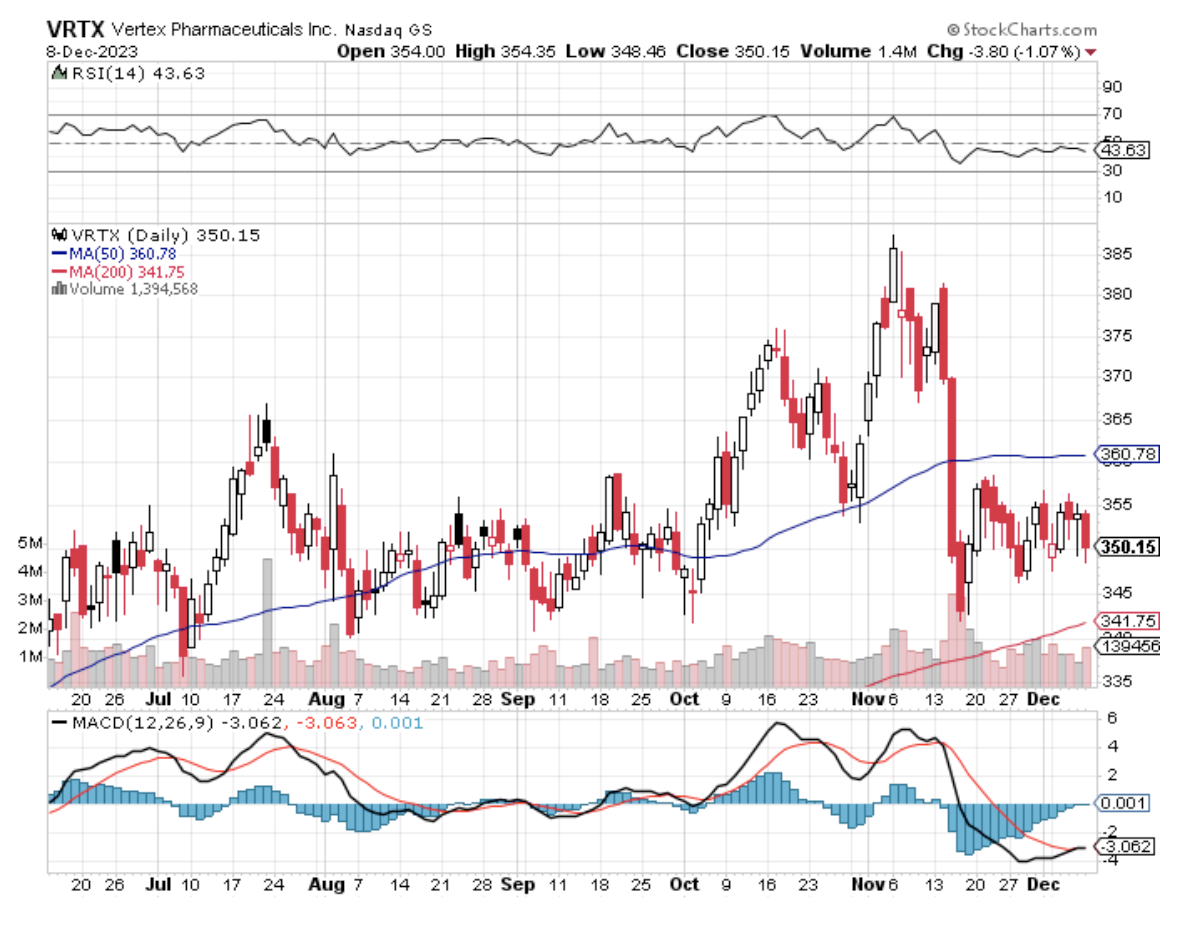
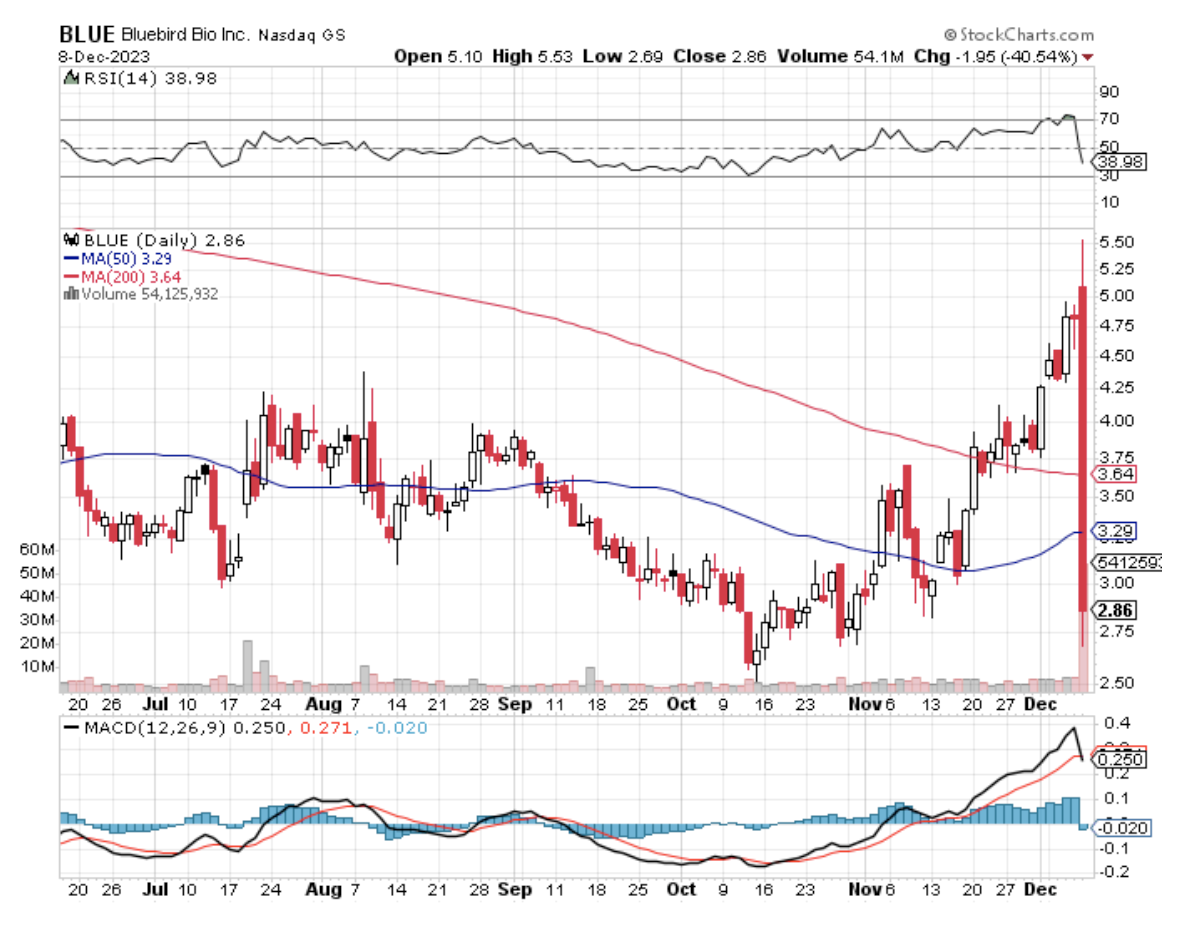
Mad Hedge Biotech and Healthcare Letter
November 2, 2023
Fiat Lux
Featured Trade:
(SLICING THROUGH DOUBT)
(CRSP), (VRTX), (BLUE), (BEAM), (AMGN), (REGN)

In the intricate world of medical breakthroughs, September 14, 1990, stands out like a sore thumb—or perhaps, a healing one.
On this day, the baseball world was left agog as Ken Griffey Jr. and Sr. knocked out back-to-back home runs, a feat as rare as hen’s teeth.
Meanwhile, in a quieter corner of the planet, a medical marvel was unfolding. Ashanti DeSilva, a 4-year-old with a genetic disorder ravaging her immune system, was about to become the poster child for gene therapy, receiving a groundbreaking treatment that involved a cocktail of modified white blood cells. The aim? To supercharge her immune system and give her a fighting chance at a normal life.
But let’s not sugarcoat it—the road from there to here was anything but a walk in the park. Gene therapy, the promising prodigy of the biotechnology and healthcare sector, had its fair share of teenage rebellion, grappling with safety concerns and delivery vehicle dilemmas. It wasn’t until the early 2010s when gene correction technologies got their act together and safer delivery systems stepped onto the scene, that gene therapy started living up to its potential.
Enter Sickle Cell Disease (SCD), the blood disorder that’s been playing hard to get, affecting around 70,000 Americans and causing everything from anemia to organ damage.
The cure seemed as elusive as a winning lottery ticket until exa-cel, the brainchild of CRISPR Therapeutics (CRSP) and Vertex Pharmaceuticals (VRTX), entered the scene.
This therapy, wielding the mighty CRISPR/Cas9 like a genetic scalpel, takes a patient's stem cells on a rollercoaster ride—harvesting, modifying, and infusing them back into the patient, with the end goal of producing healthy red blood cells.
Looking ahead, CRISPR Therapeutics and Vertex are gearing up for a potential launch of exa-cel in 2024, assuming all the stars align. This innovative gene therapy is poised to be a significant growth catalyst for both companies in the coming decade. Initially, the focus will be approximately 32,000 patients suffering from SCD and TDT.
However, investors need to brace themselves for the price tag, as gene editing therapies don't come cheap. The cost for exa-cel is anticipated to be well north of $1 million, reflecting the complexity and value of this cutting-edge treatment.
At this point, it's crucial to acknowledge that exa-cel is not the only player in this high-stakes game.
A variety of other gene therapies are also vying for the spotlight, with contenders like Bluebird Bio's (BLUE) lovo-cel, Beam Therapeutics' (BEAM) innovative base-edited candidates, and Editas Medicine's (EDIT) competitive CRISPR/Cas9 therapy all in the running.
Now, let’s talk turkey. The financial forecast for exa-cel is looking bright, with CRISPR Therapeutics poised to tap into a $48 billion market opportunity.
Although the treatment has yet to gain FDA approval, the company already has its ducks in a row. It set up 50 treatment centers in the US and 25 in Europe, as well as schmoozed with commercial payers to ensure exa-cel is as accessible as a cold beer on a hot day.
Still, let’s not put on our rose-colored glasses just yet. The biotech sector is as fickle as a cat on a hot tin roof, with CRISPR Therapeutics’ market cap doing the cha-cha in response to industry volatility. With a slew of gene therapies for SCD waiting in the wings, it’s a stark reminder that in biotech, it’s not enough to keep up—you’ve got to lead the pack.
Meanwhile, CRISPR Therapeutics is flexing its muscles with six other clinical trial programs targeting a spectrum of conditions from various cancers to type 1 diabetes, where it is ambitiously seeking a functional cure. With a robust $1.8 billion in cash, equivalents, and marketable securities as of the second quarter and a market capitalization of $3.2 billion, the company is in a strong financial position.
For the astute investors, the real gold is in playing the long game. Rather than getting caught up in the short-term ebbs and flows of the biotech market, the savvy should be pondering how to leverage the current market conditions to their advantage.
After all, CRISPR Therapeutics, with its pioneering gene-editing technology, has the potential to follow in the footsteps of biotech titans like Amgen (AMGN) and Regeneron Pharmaceuticals (REGN), both of which have turned early investments into veritable treasure troves.
Moreover, its financial stability, bolstered by its partnership with Vertex, ensures that funding woes common among smaller biotechs are less of a concern. While it may not be the largest or most prominent player in the biotech arena, the next decade could very well see CRISPR Therapeutics delivering returns that outpace the market. I suggest you buy the dip.
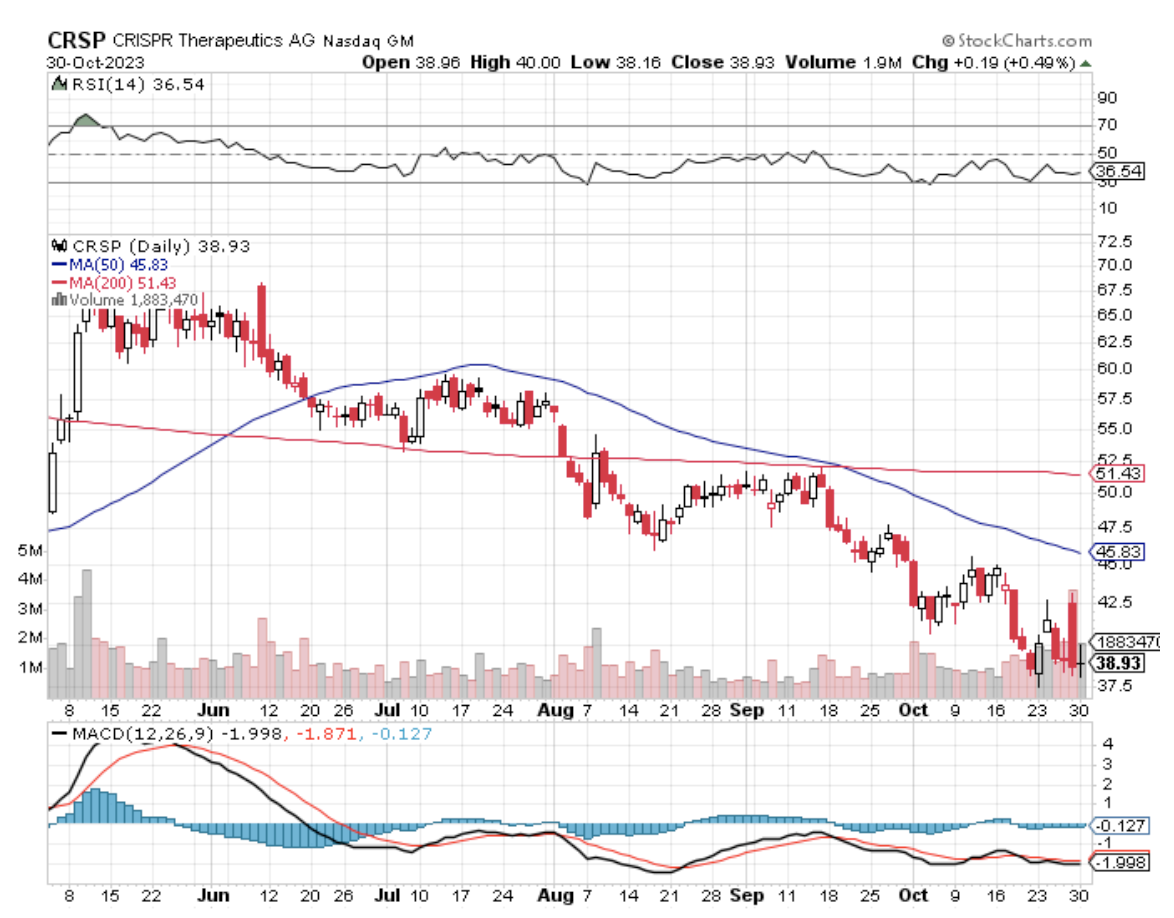
Mad Hedge Biotech and Healthcare Letter
April 20, 2023
Fiat Lux
Featured Trade:
(ANOTHER WILD RIDE IN BIOTECH)
(CRSP), (VRTX), (BLUE), (MRK), (MRNA),(RXDX)

The biotech industry is a rollercoaster of investment opportunities, where great successes and flops can easily be the difference between riches or ruin.
Companies like Moderna (MRNA) have seen this firsthand - going from a $4 billion valuation to nearly 15-fold that amount in just one successful drug launch resulting from their COVID vaccine development program. To rekindle investor interest in what may seem like an erratic space, giants such as Merck (MRK) are also putting money into promising companies; with its recent acquisition of Prometheus Biosciences (RXDX) evidence enough that even long-established pharmas recognize the potential rewards available within biotechnology markets.
Investors seeking the next big win in biotech should look beyond household names for potential gems.
Take CRISPR Therapeutics (CRSP), whose collaboration with Vertex Pharmaceuticals (VRTX) is taking exa-cel to new heights, and Bluebird Bio's (BLUE) progress on lovo-cel as just two examples of lesser-known science ahead of its time that could pay off handsomely in your portfolio.
Recent news shows that two upcoming treatments for sickle cell disease, exa-cel and lovo-cel, could be cost-effective if priced below $1.9 million - a figure the Institute of Clinical and Economic Review (ICER) concluded after conducting an extensive assessment of their financial aspects. Momentum is building as both companies aim to secure FDA approval soon; investor optimism in CRISPR continues to grow increasingly evident due to this good news.
Here’s a quick recap of the treatment’s market opportunity.
Sickle cell disease and thalassemia patients face a hefty financial burden over their lifetime, with disease-related expenses ranging from $4 million to $6 million.
As a gene-editing therapy, exa-cel is a complex treatment to manufacture and administer, which further justifies its potentially high price tag. With this innovative therapy, Vertex Pharmaceuticals and CRISPR Therapeutics aim to target 32,000 sickle cell disease (SCD) and thalassemia (TDT) patients in the United States and Europe, emphasizing the significant market opportunity for the companies.
The potential market for exa-cel, assuming a price point of $2 million, amounts to a staggering $64 billion opportunity.
While this price tag may seem steep, it is not unprecedented in the industry. Bluebird Bio, for instance, secured approval for its gene-editing medicine Zynteglo last year, pricing it at $2.8 million.
The question remains whether third-party payers will be willing to cover the high costs associated with these treatments. Case in point – Bluebird Bio exited the European market after being unable to secure favorable deals with third-party payers. As such, how exa-cel will fare in this challenging reimbursement environment is yet to be determined.
As CRISPR Therapeutics and Vertex Pharmaceuticals chart their path for the launch of exa-cel, they are keenly aware that pricing gene editing therapies rightly is critical.
Both companies have been in active dialogue with insurance providers and governmental programs like Medicaid to ensure this goal comes to fruition. Even if it means accepting modest prices for its product, there's still immense potential for exa-cel due to the lack of existing treatments meeting SCD and TDT patients' needs.
Given these details, where does CRISPR currently stand?
Investing in clinical-stage biotech stocks can be a tricky, with the potential rewards marred by the risks of what still lies ahead. However, for those brave enough to take on this challenge, there's an astronomical market opportunity at stake—the CRISPR Therapeutics and Vertex Pharmaceuticals tag team are vying against formidable foes like Bluebird’s Zynteglo as well as lovo-cel, one that could transform how SCD gene editing is treated if approved soon by FDA.
With a bigger war chest, however, Vertex may have an edge in the race, but CRISPR is no slouch, with an agreement in place to retain 40% of exa-cel's profits. It remains to be seen who will come out on top remains to be seen, but the potential rewards are undeniably huge.
As investors eagerly await the approval of exa-cel, CRISPR Therapeutics' promising gene-editing therapy for sickle cell disease, the company's market capitalization may not reflect the therapy's massive potential.
Assuming that exa-cel delivers and truly becomes a multi-billion-dollar opportunity, CRISPR Therapeutics and Vertex Pharmaceuticals are poised to capture a significant market share with their forthcoming therapies. With the advantage of a stronger cash position, Vertex could push the scales in its favor, helping with the therapies' launch.
Even conservatively assuming profits of $12 billion, CRISPR Therapeutics' market cap of $3.6 billion does not do justice to the company's potential.
While it's still early days, CRISPR Therapeutics' other promising programs should not be ignored. The company is somewhat fairly valued, but exa-cel's approval could send its shares soaring.
Beyond the financial benefits, the success of exa-cel could also bolster CRISPR Therapeutics' position as a leader in gene editing technology.
The company's pipeline includes promising programs in immuno-oncology and rare diseases, and the sustained revenue generated by exa-cel could fuel further research and development efforts. This bodes well for the stock's prospects, as CRISPR Therapeutics continues to advance the frontiers of innovative medicine.
Meanwhile, another possibility for CRISPR is a buyout.
The gene-editing market may be small, but its rapid growth rate of nearly 30% until 2030 presents an enticing opportunity for healthcare businesses to pursue. The market is estimated to reach less than $15 billion by then. With an approved gene-editing therapy, CRISPR Therapeutics could be a valuable asset for a larger healthcare company seeking growth.
At a market cap of less than $4 billion, CRISPR Therapeutics is an affordable acquisition for a top healthcare company looking to expand its portfolio. The company's favorable balance sheet, with over $1.8 billion in cash and short-term investments and modest debt of just over $244 million, makes it even more appealing as a potential acquisition.
The acquisition of CRISPR's business wouldn't come with a lot of headaches, and it could instantly boost a company's growth prospects.
With the sustained revenue from exa-cel and the potential for more clinical and regulatory wins in its other programs, CRISPR Therapeutics' gene-editing pipeline is worth considering for any healthcare business looking to capitalize on the promising growth opportunities in this market.
Overall, the potential for significant upside in the short and mid-term, combined with the company's pioneering spirit, makes CRISPR Therapeutics an attractive investment opportunity for discerning investors.
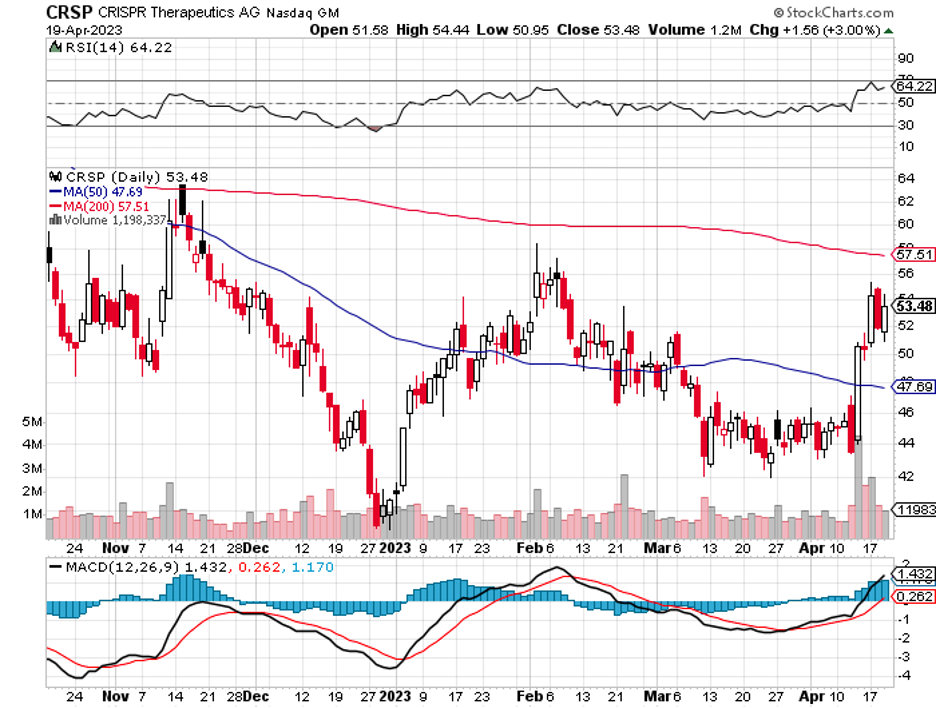
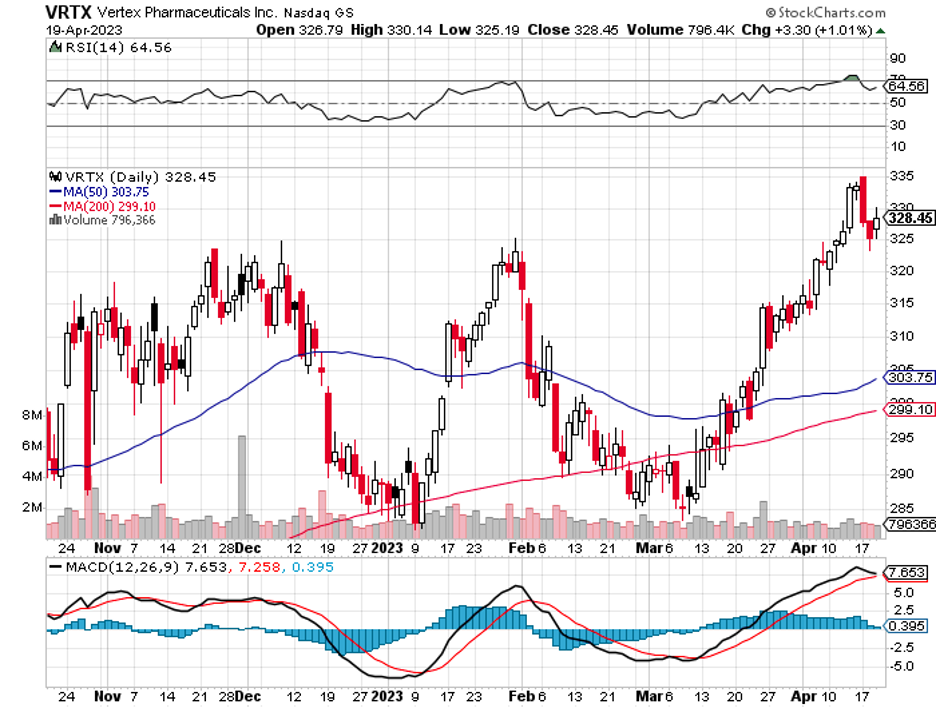
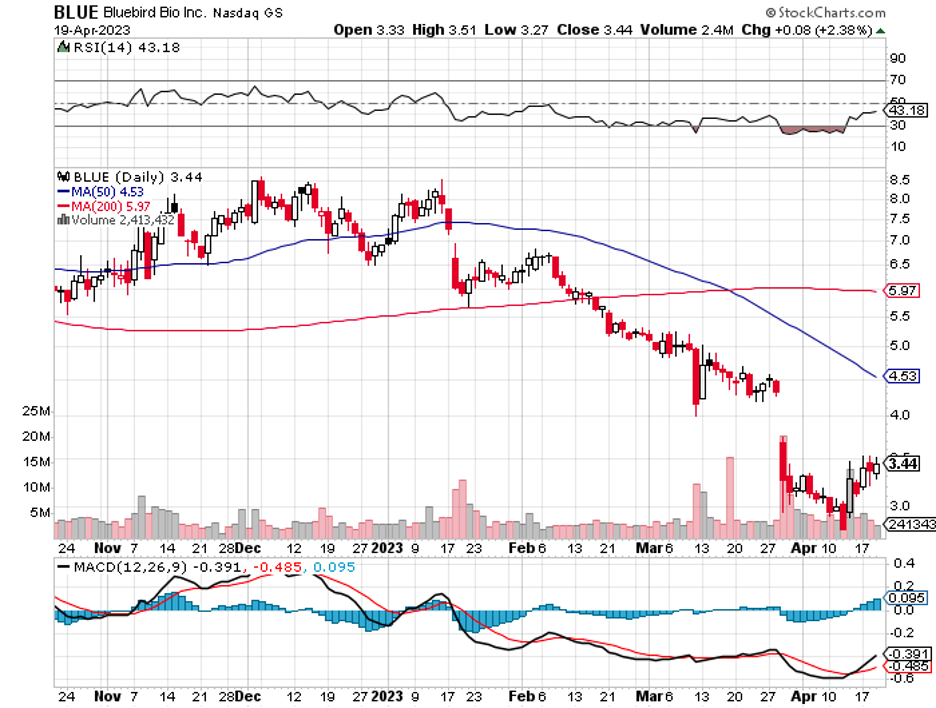
Mad Hedge Biotech and Healthcare Letter
April 18, 2023
Fiat Lux
Featured Trade:
(A BEAR MARKET BARGAIN)
(VRTX), (CRSP), (BLUE)
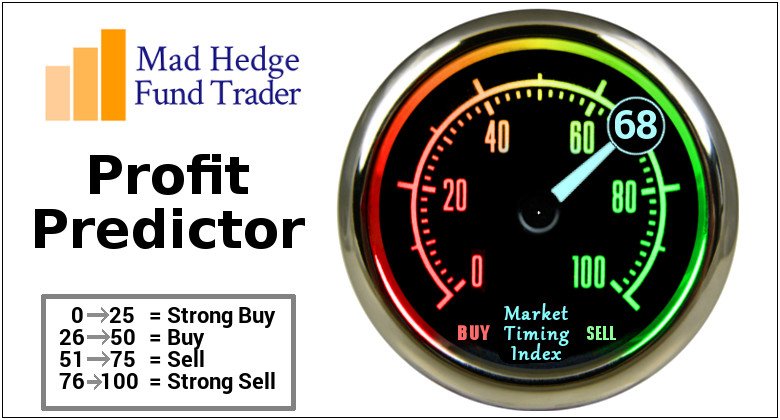
When the Nasdaq Composite fell by 33%, it created the ideal excuse for savvy investors to pounce on high-quality discounted stocks.
While it can be one of the most uncomfortable learning experiences, Wall Street reminded investors last year that even the most promising stocks can and will plunge into unimaginable depths as quickly as they can skyrocket.
However, here’s a fascinating thing about the slipping prices courtesy of the bear market: These present a rare red-carpet chance for long-term investors. Although the Nasdaq Composite has been experiencing back-to-back double-digit corrections, a bull market almost always recoups its losses eventually.
Vertex Pharmaceuticals (VRTX) stands out as one of the most exciting growth stocks that investors should consider in the biotechnology and healthcare sector.
For the uninitiated, Vertex has become synonymous with cystic fibrosis (CF) treatments.
CF is a genetic disorder that affects the respiratory, digestive, and reproductive systems. It causes the production of thick and sticky mucus in these organs, leading to serious health problems. The global market for cystic fibrosis treatments is projected to reach $18.9 billion by 2027.
Vertex currently holds six approved CF treatments. Among these, the combination therapy Trikafta, also known as Kaftrio in the EU, stands out as their top-selling product. In 2022, Trikafta's sales surged to $7.6 billion from $3.8 billion in 2020, driving revenue growth.
Given its dominance in the market, it’s clear that no other drugmaker comes even close to challenging Vertex when it comes to CF. To boot, this biotech leader has several new areas of focus that hold the potential of not only delivering fresh revenue streams but also turning into blockbusters soon.
Actually, Vertex is a step closer to launching a new blockbuster in the form of a new type of treatment called exa-cel, which uses gene-editing technology to fix the genetic defect that leads to rare and often untreatable diseases.
The biotech and its co-developer, CRISPR Therapeutics (CRSP), recently submitted their application to the FDA to approve their sickle cell disease and beta-thalassemia treatments. The two companies are also waiting for approvals from the EU.
Based on the prevalence of these genetic blood disorders, the lack of effective treatments, and the potential of Vertex and CRISPR’s candidates to provide a one-time cure, the market size for exa-cel treatments for beta-thalassemia and sickle cell disease is estimated to be worth a total of $3.5 billion annually.
But, Vertex appears to have more plans for exa-cel.
For context, here is how exa-cel is applied to treatments for sickle cell disease and beta-thalassemia: the patient's own stem cells are collected and edited using CRISPR/Cas9 technology, creating exa-cel cells. These cells are then infused back into the patient after a conditioning process, which is currently done through chemotherapy with the drug Busulfan.
However, this approach is risky and has caused adverse effects in clinical trials. As a result, some patients with these conditions may not be able to benefit from exa-cel.
This concern prompted Vertex to explore new conditioning agents for exa-cel treatments that may be less aggressive on the body. They have licensed ImmunoGen's (IMGN) antibody-drug conjugate (ADC) technology, which is commonly used in cancer treatments to deliver cancer-killing agents directly to cancer cells without harming other cells.
ADCs are often used in cancer treatments to target cancer cells, specifically, sparing healthy cells from damage. This technology can potentially make the exa-cel treatment safer and more accessible for patients.
Regarding competitors, the frontrunner would be Bluebird Bio (BLUE). This was the first biotech to submit a sickle cell disease treatment candidate to the FDA. Unfortunately, its approval has faced delays. Still, Bluebird remains the only biotech that could be considered a direct rival of Vertex and CRISPR.
Apart from these, Vertex has two additional pipeline programs queued for launch by 2024.
The biotech expects to finalize its late-stage clinical trials for VX-548, a non-opioid pain treatment, by the first quarter of 2024. Vertex is also assessing a triple-drug combo targeting CF. Both candidates hold the promise of delivering over $2 billion in sales annually.
In addition, Vertex has been aggressive in acquiring companies to expand its portfolio.
Just last year, the biotech signified its plan to become an active player in the diabetes space when it bought ViaCyte and Catalyst Bioscience. Based on the portfolio of the acquired companies, Vertex appears to be making headway in developing stem cell treatments for Type 1 diabetes.
What do these developments mean? Well, it’s critical to review the whole picture.
Vertex already rakes in billions of dollars from its CF treatment franchise, and it’s highly plausible that the biotech will sustain its monopoly of the market for years to come.
At the same time, the company is also aggressively widening its reach and expanding into more lucrative segments. In short, the company is clearly on a roll. Given its track record and steady progress, it is an excellent long-term stock. I suggest you buy the dip.
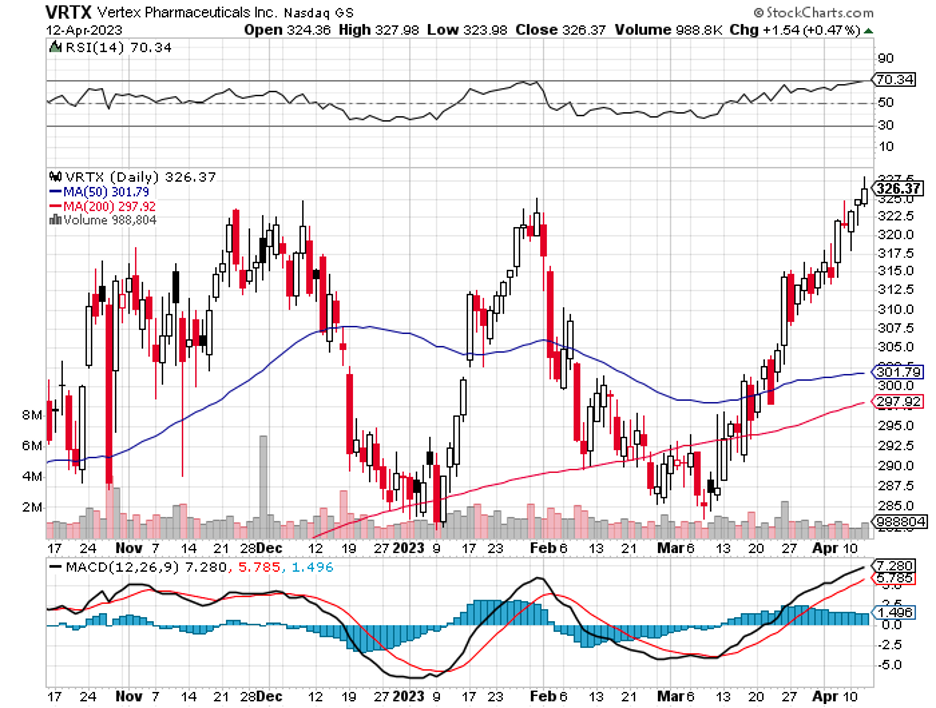
Legal Disclaimer
There is a very high degree of risk involved in trading. Past results are not indicative of future returns. MadHedgeFundTrader.com and all individuals affiliated with this site assume no responsibilities for your trading and investment results. The indicators, strategies, columns, articles and all other features are for educational purposes only and should not be construed as investment advice. Information for futures trading observations are obtained from sources believed to be reliable, but we do not warrant its completeness or accuracy, or warrant any results from the use of the information. Your use of the trading observations is entirely at your own risk and it is your sole responsibility to evaluate the accuracy, completeness and usefulness of the information. You must assess the risk of any trade with your broker and make your own independent decisions regarding any securities mentioned herein. Affiliates of MadHedgeFundTrader.com may have a position or effect transactions in the securities described herein (or options thereon) and/or otherwise employ trading strategies that may be consistent or inconsistent with the provided strategies.
This site uses cookies. By continuing to browse the site, you are agreeing to our use of cookies.
OKLearn moreWe may request cookies to be set on your device. We use cookies to let us know when you visit our websites, how you interact with us, to enrich your user experience, and to customize your relationship with our website.
Click on the different category headings to find out more. You can also change some of your preferences. Note that blocking some types of cookies may impact your experience on our websites and the services we are able to offer.
These cookies are strictly necessary to provide you with services available through our website and to use some of its features.
Because these cookies are strictly necessary to deliver the website, refuseing them will have impact how our site functions. You always can block or delete cookies by changing your browser settings and force blocking all cookies on this website. But this will always prompt you to accept/refuse cookies when revisiting our site.
We fully respect if you want to refuse cookies but to avoid asking you again and again kindly allow us to store a cookie for that. You are free to opt out any time or opt in for other cookies to get a better experience. If you refuse cookies we will remove all set cookies in our domain.
We provide you with a list of stored cookies on your computer in our domain so you can check what we stored. Due to security reasons we are not able to show or modify cookies from other domains. You can check these in your browser security settings.
These cookies collect information that is used either in aggregate form to help us understand how our website is being used or how effective our marketing campaigns are, or to help us customize our website and application for you in order to enhance your experience.
If you do not want that we track your visist to our site you can disable tracking in your browser here:
We also use different external services like Google Webfonts, Google Maps, and external Video providers. Since these providers may collect personal data like your IP address we allow you to block them here. Please be aware that this might heavily reduce the functionality and appearance of our site. Changes will take effect once you reload the page.
Google Webfont Settings:
Google Map Settings:
Vimeo and Youtube video embeds:
